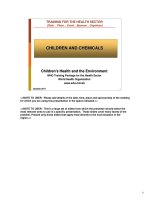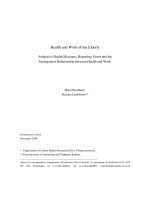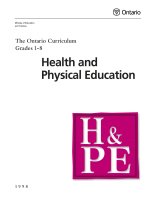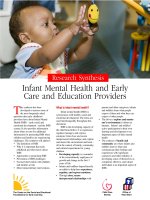Treatment Planning for Person-Centered Care: The Road to Mental Health and Addiction Recovery docx
Bạn đang xem bản rút gọn của tài liệu. Xem và tải ngay bản đầy đủ của tài liệu tại đây (2.74 MB, 315 trang )
Treatment Planning for
Person-Centered Care:
The Road to Mental
Health and Addiction
Recovery
This Page Intentionally Left Blank
Treatment Planning for
Person-Centered Care:
The Road to Mental
Health and Addiction
Recovery
Mapping the Journey for Individuals,
Families, and Providers
Neal Adams, MD, MPH
Diane Grieder, MEd
AMSTERDAM • BOSTON • HEIDELBERG • LONDON
NEW YORK • OXFORD • PARIS • SAN DIEGO
SAN FRANCISCO • SINGAPORE • SYDNEY • TOKYO
Elsevier Academic Press
30 Corporate Drive, Suite 400, Burlington, MA 01803, USA
525 B Street, Suite 1900, San Diego, California 92101-4495, USA
84 Theobald’s Road, London WC1X 8RR, UK
This book is printed on acid-free paper. ϱ
Copyright ß 2005, Elsevier Inc. All rights reserved.
No part of this publication may be reproduced or transmitted in any form or by any
means, electronic or mechanical, including photocopy, recording, or any information
storage and retrieval system, without permission in writing from the publisher.
Permissions may be sought directly from Elsevier’s Science & Technology Rights Department in
Oxford, UK: phone: (ỵ44) 1865 843830, fax: (ỵ44) 1865 853333, e-mail: permissions@elsevier.
co.uk. You may also complete your request on-line via the Elsevier homepage (http://
elsevier.com), by selecting ‘‘Customer Support’’ and then ‘‘Obtaining Permissions.’’
Library of Congress Cataloging-in-Publication Data
Application submitted.
British Library Cataloguing in Publication Data
A catalogue record for this book is available from the British Library.
ISBN: 0-12-044155-1
For information on all Elsevier Academic Press publications
visit our Web site at www.books.elsevier.com
Printed in the United States of America
04 05 06 07 08 09 9 8 7 6 5 4 3 2 1
Acknowledgments
As all authors note, this book could not have been written without the
assistance and support of many people. Similar to the team assisting the
individual to achieve his or her goals in the person-centered approach, we
have also had a team accompanying us on our first book-writing journey.
Sincere thanks to our editor, Nikki Levy, who warned us, ‘‘writing a book
will be the hardest thing you ever do,’’ and she was right!
Many thanks to our colleagues who were willing to read, offer comments and support, and even edit portions of the book as it evolved: Ed
Diksa, Wilma Townsend, Nirbay Singh, John Morris, Lesa Yawn, Nikki
Migas, Wendy Graddison, Yana Jacobs, Penny Knapp, Sherry Kimbrough,
and James W. Baxter.
Thanks are also due to the many individuals receiving services we have
met in our professional careers, who have been a source of inspiration to us.
They have taught us how to listen, to have hope, and to believe in them.
Most importantly, thanks to our respective families, who joined us on
this road trip—sometimes willingly, sometimes not—and were the fountains of support, encouragement, understanding, and forgiveness that made
writing this book possible. To our spouses, Lucy and Marion, and to our
children, Alyssa, Caleb, Parris, and Zachary, we will be forever grateful.
Treatment Planning for Person Centered Care
Copyright ß 2004 by Academic Press. All rights reserved.
v
This Page Intentionally Left Blank
Contents
Acknowledgments
v
Prologue
xi
Foreword
xv
Preface
xix
SECTION I
Planning the Trip
1
Introduction: Planning the Trip
2
Person-Centered Care
17
3
The Value of Individual Planning
39
Treatment Planning for Person Centered Care
Copyright ß 2004 by Academic Press. All rights reserved.
3
vii
viii
Contents
S E C T I O N II
Getting Started
4
Assessment
57
5
Understanding Needs: The Narrative Summary
91
S E C T I O N III
On the Road
6
Setting Goals
119
7
Focusing on Change: Specifying the Objectives
139
8
Interventions
155
S E C T I O N IV
Journey’s End: The Destination
9
Evaluating the Process
179
Epilogue
211
Contents
ix
APPENDICES
Learning by Example
1
Aaron Howard
215
2
Sally Hamilton
237
3
Sam Hewlett
253
4
Carmen Suarez
265
This Page Intentionally Left Blank
Prologue
Providers should consider this book one of the most important instructional
tools in the field of mental health and addictive disorders. As an individual
who began her professional life as a case manager, who later moved into
administration and management, and who now works as a consumer
advocate and consultant, I know that there has traditionally been little
practical teaching about how to develop a treatment plan, or why it is
important beyond its role in financial reimbursement. The value of a plan as
a road map to assist the individual in their treatment process was never
considered. There is a real need for a book that can assist all participants in
mental health and addiction recovery to master the skills of a personcentered approach to developing individual plans.
Later, in my capacity as the chief of the Office of Consumer Services
within the Ohio Department of Mental Health, the importance of an
individual plan was immediately germane to our discussions about ‘‘what
is recovery?’’ This in part led to the development of the booklet Emerging
Best Practices in Mental Health Recovery1. That book was the result of work by
consumers, families, clinicians, and researchers who studied the consumer’s
recovery process and the role of providers and the community in assisting
them. Emerging Best Practices also led to the development of a curriculum on
‘‘Clinicians Facilitating a Consumers Recovery Process,’’ which supported
the development of a recovery management plan (RMP)/treatment plan.
We found that language is crucial in the recovery process; changing the
1
Ohio Department of Mental Health, 1999.
Treatment Planning for Person Centered Care
Copyright ß 2004 by Academic Press. All rights reserved.
xi
xii
Prologue
name of the document put the focus on the individual instead of putting
the focus on the illness, as the term treatment plan seemed to do.
I have since left the Department of Mental Health and have been
working with behavioral health systems on the implementation of the
Emerging Best Practices in Mental Health model. This includes a very
specific structure to assist providers and consumers in implementing
person-centered care. I have trained providers and consumers, sometimes
together, on this structure. I have also guided them in the journey of
putting this process and form into practice. The journey is the individual’s
journey, so the individual must be the one who makes the final choices. In
making these decisions, it is important that there is a structure to promote a
dialogue between the individual and the provider about possibilities and
choices. The creation of a person-centered plan can provide that structure
and help the individual, in partnership with the provider, to identify
long- and short-term goals for the consumer to work towards with their
caregivers.
An RMP is a person-centered plan. In an RMP, all goals are written in
both clinical terms as well as layperson language so that both the consumer
and provider can relate to aspects of the RMP from their own perspective.
Using the individual’s own words, the RMP helps to identify the skills,
knowledge, and action steps/interventions necessary to meet the goals. It
also provides an opportunity for the individual to identify activities in the
community that they want to pursue or organizations in the community
can assist them in accomplishing their goals. The individual and the provider then decide how the provider can best assist them in accomplishing
their goal. Oftentimes the RMP is actually completed by the individual,
who is then given a copy to take home.
This process is all about helping the individual make decisions rather than
the provider being the decision-making authority. It is about the individuals
taking on more responsibility in their own recovery processes. Over time the
individual will better understand that his or her illness is just one dynamic in
their life. It is about enabling both the provider and the individual to
recognize that in order to live, work, and have a meaningful life in the
community, individuals must learn to make decisions for themselves and
not rely forever on 24/7 supports. It is the individual’s life to be lived.
In attempting to introduce these new approaches to established practice
settings, many providers typically respond by saying: ‘‘ . . . but we are
already doing this’’ (i.e., person-centered planning). It is only after being
trained and practicing this process that they realize it is really quite different.
They realize that in the past they have not used a structure that truly
Prologue
xiii
enabled the individual to express and fulfill his or her partnership role in
treatment and recovery. Providers come to realize that the individual needs
to more actively exercise options and choices, make decisions, and be
accountable for his or her actions. Providers see, in contrast, how they
have been unwittingly making decisions and directing care.
After several years of experience in many different sites and settings, it is
clear to me and others that a person-centered approach can and does make a
real difference for individuals and supports their growth and recovery (see
the epilogue for a collection of individual recovery stories). Providers who
have developed skills in person-centered planning appreciate the importance of treatment plans beyond reimbursement and administrative requirements. The real goal of person-centered planning is for the provider and
individual, in partnership, to create a road map for reaching the individual’s
goals—and at the same time documenting medical necessity and supporting
billing.
Not only am I a provider and trainer, I am also a person who has
received services within the behavioral health care field and whose provider
used a person-centered approach to planning and creating my personal road
map to recovery. Because of this, I felt like I was a part of the process, that
the process was about my recovery and me, and I was able to truly benefit
from services.
It is very important and necessary for individuals pursuing mental health
and addiction recovery to design their own road map. This book will assist
providers in understanding their role in the journey of developing and
facilitating an individual’s road map through person-centered planning.
Wilma Townsend
This Page Intentionally Left Blank
Foreword
This book offers an exciting, dynamic, and fresh approach to the challenges
of developing individual plans for mental health and addiction services. Our
goal is to help make planning a manageable task for providers, a meaningful
process for individuals receiving services, and a resource tool to assure
person-centered care and optimal outcomes.
It should be clearly stated at the outset that this book is not a how-to
manual for completing forms. Rather, the focus should be on the process of
using the service plan to build effective and collaborative healing partnerships
with individuals and families in pursuit of resilience, wellness and recovery.
This book was written with a focus towards relevance for all providers and
settings, ranging from traditional one-to-one approaches in private practice
to multidisciplinary teams in community care organizations or residential and
inpatient facilities. Using a practical approach, rich with examples adapted to
a wide range of adult learning styles, it is intended to be suitable and valuable
for an independent reader or classroom learning. The book is intended to
help students and experienced providers improve their ability to develop
person-centered plans that enhance the value and efficacy of services. In this
way, providers will be better able to develop an individual plan that optimizes
outcomes for the individual as well as meet the requirements of payers,
accreditation standards, regulatory bodies, and so on.
We believe that there is also a need for this kind of text for students in
pre-degree training programs as well as for established professionals who
want to respond to important changes and trends sweeping through all of
health care. Service recipients, families, advocates, policy makers, and
others should all find useful information and resources in these chapters.
Treatment Planning for Person Centered Care
Copyright ß 2004 by Academic Press. All rights reserved.
xv
xvi
Foreword
A recovery-oriented system or program can be defined as having values of a
person orientation (a focus on the individual who has strengths, talents, and
interests, rather than the person as a case or a diagnostic label), person involvement (the individual’s right to participate in all aspects of the service, including
designing the individual plan, and implementing and evaluating services), selfdetermination/choice (a person’s right to make decisions and choices about all
aspects of their treatment, such as desired outcomes and preferred services),
and growth potential (given the opportunity and necessary resources, the inherent capacity of any individual to recover, grow, and change).
It is becoming increasingly clear that a person-centered approach to care,
in which the recipient of services is the driving force in the development of
his or her individual plan, is a de facto standard of quality. The importance
of choice, empowerment, and engagement are recognized as keys to
effective care and positive outcomes, not only in mental health and substance abuse but in general health care as well.
This book attempts to blend a commitment to recovery, resiliency, and
wellness with a practical, simple, and straightforward approach so that all
readers—from students to providers—will develop the skills that they need
to write effective plans. The various sections include strategies, tips, and
sample plans and forms, as well as illustrative examples to help practitioners
succeed in the ever-evolving health care delivery system.
To help the reader more easily access the information in this book, there
are several layers of content focus, with the chapters organized into four
sections. Each section describes the various phases of a trip; seeing the
pursuit of wellness and recovery as a journey is a useful way of thinking
about the steps and processes that need to be considered in developing a
person-centered plan.
With this metaphor in mind, an individual plan can easily be thought of
as a map. Few people begin a journey without some sense of destination
and at least a preliminary route. Together, the individual seeking services
and the provider develop the individual plan (map) that will hopefully lead
to the recovery goal or outcome (destination) the individual wants to
achieve. The intermediate steps are the objectives of the individualized
plan (sites to visit along the trip). The services/interventions (route) help
assure that each intermediate step is reached.
In addition, each chapter is organized into three parts:
.
.
.
Stating the Case
Creating the Solution
Making It Happen
Foreword
xvii
Stating the Case is a look at the status quo as well as emerging trends in
both theory and practice. Creating the Solution presents the essentials of a
person-centered approach to preparing and implementing individual plans.
Making It Happen includes examples of plans as well as strategies for
changing systems and practices.
As all travelers know, a map is an indispensable tool to help guide the
journey. Thinking about individual planning as a trip to be mapped helps us
to better explore and understand the process. Ultimately, creating a plan is
about helping an individual to envision their own journey (creating a map
that directs their trip). At the same time, our ability to be helpful and stay
on track is enhanced by having the course laid out and the destination
identified.
Bon voyage!
Neal Adams, MD, MPH
Diane Grieder, MEd
This Page Intentionally Left Blank
Preface
The use of language is often anchored in history, tradition, assumptions,
and values. Words communicate ideas that go beyond the terms and phrases
themselves. But this is by no means static; there are trends and periodic
shifts that impact how we think and understand the world around us and
help to shape the work that we do. Accordingly, a few comments about
language must precede the text that follows.
Our desire is to make this book as useful and relevant as possible to the
needs of the broadest audience without being limited to any particular
practice model, philosophy, or professional discipline beyond a commitment to person-centered care. This requires the thoughtful use of language
and an attempt at neutrality. While there are those who decry as well as
those who celebrate political correctness, there is no question that the use
of language can either engage, distract, or even repel a reader. After
considerable discussion, we elected the following lexicon to use in discussing the principles and practice of developing plans to meet the needs of
individuals and families receiving services.
For the focus of this book itself, the plan is often referred to as an
individual treatment plan, an individual services plan (ISP), a consumer
services plan (CSP), an individual recovery management plan (RMP), an
integrated plan, a service coordination plan, and so forth. For our purposes,
we have settled on the simple term individual plan, which stresses the notion
of person-centeredness.
We use the term individual to refer to patients, clients, residents,
members, users, consumers, and persons served. Some words imply
Treatment Planning for Person Centered Care
Copyright ß 2004 by Academic Press. All rights reserved.
xix
xx
Preface
passivity, while others connote participation. Language that respects the
dignity as well as unique attributes and needs of all people is critically
important. Oftentimes throughout the book, references to the individual
are tied to the family. For children and adolescents, it should be a given that is
always implied, if not explicitly stated, that family is essential to understanding and responding to the needs of the individual. For adults, it is recognition
of the important role that family plays in all of our lives—for better or for
worse. Family may be defined in traditional terms or may be a constellation of
relatives and friends determined by the individual. Regardless, that essential
support network commonly referred to as family should almost always be
considered in planning mental health and addiction services.
We have chosen the term services to refer to what in some settings might
be called treatment, care, support, therapy, rehabilitation, and so forth.
Recognizing that there are different models, different philosophies and
attitudes, and a range of professional disciplines and clinical traditions
(including both licensed and degreed as well as paraprofessional and peer
providers), we felt that services was the most neutral and inclusive term to
use at this time.
The term narrative summary is used within this book to describe what
might be called an interpretive summary, diagnostic summary, or clinical
formulation. It is an essential but often overlooked part of assessment and
planning which attempts to create meaning and relevance from the factual
database of the assessment. Understanding each individual and their unique
circumstances and needs should be clearly articulated and documented.
Additionally, we settled on the term provider to describe people frequently referred to as doctor, clinician, counselor, therapist, psychologist,
case manager, nurse, aide, caregiver, treatment team, self-help peer, and so
forth, working in a wide range of settings. All of these roles and titles hold
in common their service to people in need of assistance and support.
Alternatively referred to as a chart, medical record, documentation,
client or patient record, electronic record, health information, and so
forth, we felt that the simple term record was sufficient. Regardless of format
or organization—from 19th century pen and paper to 21st century data
systems—creating and maintaining a record of our assessments, our understanding, the plan of action, and services provided remains a key part of our
job.
The idea of recovery is referenced throughout the book. This is an
emerging concept in mental health and reflects a new way of thinking
about the impact of services and the importance of individual goals and
outcomes. Wellness, resiliency, and rehabilitation are among many other
Preface
xxi
terms often used interchangeably. At the same time, the term recovery has
had long-standing use in the addiction treatment field where it conveys a
lifelong process of facing one’s challenges and vulnerabilities. We believe
that the idea of recovery should be a central theme and shared universal
goal for all of mental health and addiction services.
We recognize that not everyone will necessarily agree with our choices.
At the same time, we hope that no one will find them off-putting or
offensive. We trust that each reader can translate these terms into those
words and phrases that best fit their own perspective, philosophy, setting,
and work. Hopefully the values and principles that follow will prove
durable and transcend the limitations and constraints of language.
We have written this book based upon our collective years of study and
practical experience in the field as providers, trainers, administrators, surveyors, and consultants. Too often we have seen quality programs and topnotch providers fall short of their potential to succeed and excel because of
problems in individual planning. Too often we have witnessed individuals
in need of help disappointed and frustrated at not receiving the services and
benefits they need and deserve. Our belief is that effective and meaningful
planning for service delivery does make a difference.
We have had the satisfaction of seeing providers, along with individuals
receiving services, celebrate their shared satisfaction and success when lives
are changed and people achieve their own vision of wellness, resilience, and
recovery. This book is dedicated to and reflective of our commitment to
the spirit that makes us each uniquely human. Its inspiration lies in understanding the power of one person’s care for another, and the value of
thoughtful planning as we work to help those who ask for our assistance.
This Page Intentionally Left Blank
SECTION I
Planning the Trip
The essential task in planning this journey of discovery and
learning is to fully understand the relevance and importance
of individual plans in contemporary mental health and addiction recovery practice, regardless of the setting or population
served. Similar to the earlier stages of considering a trip, this
section provides both history and background along with an
overview of current trends and issues in assessment, individual planning, and documentation.
The notion of person-centered care was once a defining
feature of rehabilitation approaches. Now it is no longer isolated to rehabilitation practice. The importance of personcentered approaches to care is reshaping practice throughout
health care. Understanding what is meant by person-centered
care, and clarifying the role of both the provider and the person
served, are crucial to successful planning and outcomes.
At the end of this section, the importance, value, and
relevance of undertaking this trip should be clear. Then,
knowing the destination, the traveler can make the necessary
plans and prepare for the beginning of the journey.
This Page Intentionally Left Blank









